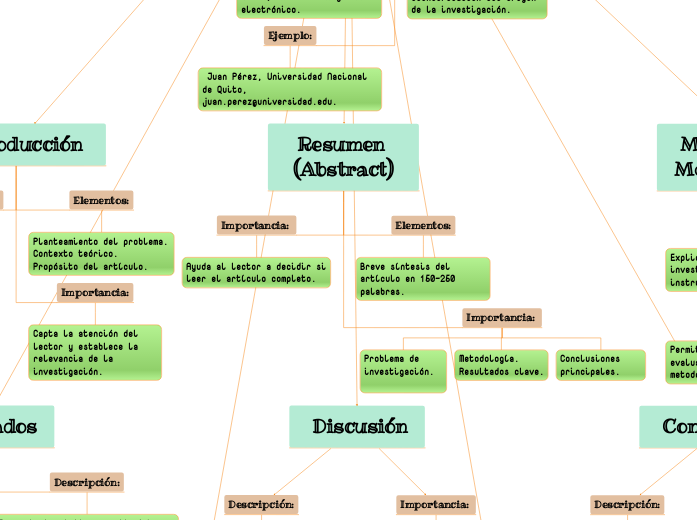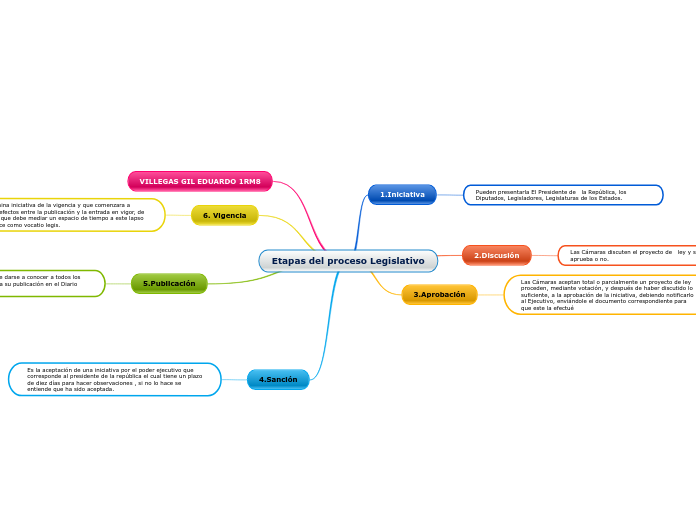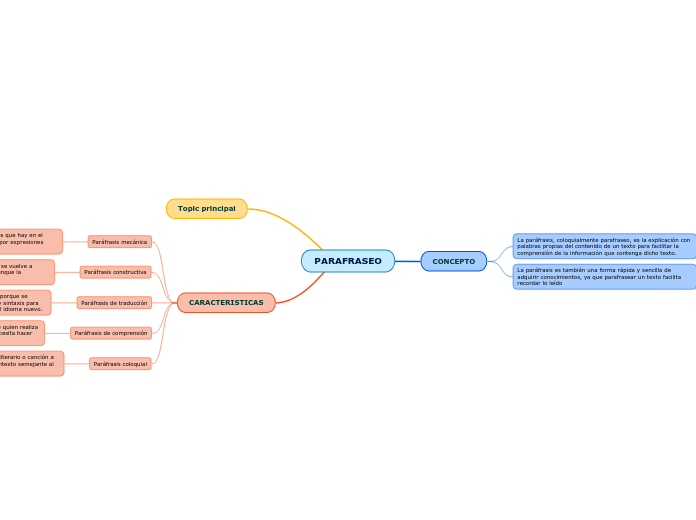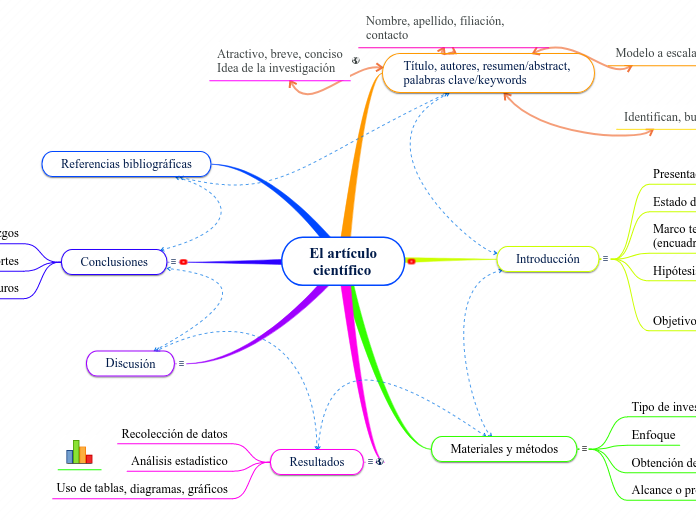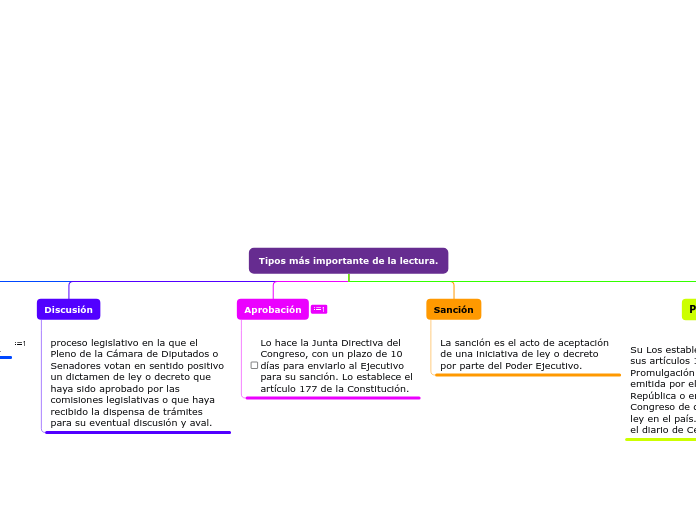Estructura de un Artículo Científico
Type in the name of the multiple-perspectives text.
Example: Bridge to Terabithia by Katherine Paterson
Anexos (Opcional)
Profundiza en aspectos específicos sin saturar el texto principal.
Información adicional que complementa el artículo (tablas, figuras, encuestas).
Type in a relevant quote that highlights the character's point of view towards
Anexos (Opcional).
Try following a citation format: author's name, chapter, and page.
Example: 'Jesse drew the way some people drank whiskey. (...) Lord, he loved to draw. (...) When he was in first grade, he told his father that he wanted to be an artist when he grew up.' (Paterson, 2. 7)
Referencias
Permite verificar la información y respalda la credibilidad del trabajo.
Lista de todas las fuentes citadas en el artículo
Type in a relevant quote that highlights the character's point of view towards
Referencias.
Try following a citation format: author's name, chapter, and page.
Example: 'Jesse drew the way some people drank whiskey. (...) Lord, he loved to draw. (...) When he was in first grade, he told his father that he wanted to be an artist when he grew up.' (Paterson, 2. 7)
Conclusiones
Señala el aporte principal de la investigación y líneas futuras
Resume las implicaciones de los resultados y posibles aplicaciones.
Type in a relevant quote that highlights the character's point of view towards
Conclusiones.
Try following a citation format: author's name, chapter, and page.
Example: 'Jesse drew the way some people drank whiskey. (...) Lord, he loved to draw. (...) When he was in first grade, he told his father that he wanted to be an artist when he grew up.' (Paterson, 2. 7)
Discusión
Interpreta los hallazgos, compara con estudios previos y plantea implicaciones futuras.
Analiza los resultados en relación con la literatura existente.
Type in a relevant quote that highlights the character's point of view towards
Discusión.
Try following a citation format: author's name, chapter, and page.
Example: 'Jesse drew the way some people drank whiskey. (...) Lord, he loved to draw. (...) When he was in first grade, he told his father that he wanted to be an artist when he grew up.' (Paterson, 2. 7)
Resultados
Proporciona evidencia empírica clara y organizada
Presenta los hallazgos obtenidos en la investigación.
Type in a relevant quote that highlights the character's point of view towards
Resultados.
Try following a citation format: author's name, chapter, and page.
Example: 'Jesse drew the way some people drank whiskey. (...) Lord, he loved to draw. (...) When he was in first grade, he told his father that he wanted to be an artist when he grew up.' (Paterson, 2. 7)
Materiales y Métodos
Permite la replicabilidad y la evaluación crítica de la metodología.
Explica cómo se realizó la investigación (procedimientos, instrumentos, participantes).
Type in a relevant quote that highlights the character's point of view towards
Materiales y Métodos.
Try following a citation format: author's name, chapter, and page.
Example: 'Jesse drew the way some people drank whiskey. (...) Lord, he loved to draw. (...) When he was in first grade, he told his father that he wanted to be an artist when he grew up.' (Paterson, 2. 7)
Resumen (Abstract)
Ayuda al lector a decidir si leer el artículo completo.
Conclusiones principales.
Metodología.
Resultados clave.
Problema de investigación.
Breve síntesis del artículo en 150-250 palabras.
Type in a relevant quote that highlights the character's point of view towards
Resumen (Abstract).
Try following a citation format: author's name, chapter, and page.
Example: 'Jesse drew the way some people drank whiskey. (...) Lord, he loved to draw. (...) When he was in first grade, he told his father that he wanted to be an artist when he grew up.' (Paterson, 2. 7)
Introducción
resenta el problema, antecedentes y objetivos del artículo.
Capta la atención del lector y establece la relevancia de la investigación.
Elementos:
Planteamiento del problema.
Contexto teórico.
Propósito del artículo.
Type in a relevant quote that highlights the character's point of view towards
Introducción.
Try following a citation format: author's name, chapter, and page.
Example: 'Jesse drew the way some people drank whiskey. (...) Lord, he loved to draw. (...) When he was in first grade, he told his father that he wanted to be an artist when he grew up.' (Paterson, 2. 7)
Palabras clave
3-5 términos que representan el contenido del artículo.
Redes sociales, adolescentes, comportamiento, psicología.
Facilitan la indexación y recuperación del artículo en bases de datos.
Type in a relevant quote that highlights the character's point of view towards
Palabras clave.
Try following a citation format: author's name, chapter, and page.
Example: 'Jesse drew the way some people drank whiskey. (...) Lord, he loved to draw. (...) When he was in first grade, he told his father that he wanted to be an artist when he grew up.' (Paterson, 2. 7)
Autor(es) y Afiliación
Ejemplo:
Decide on the second point of view
Name the character (it can either be the main character or one of the supporting characters) whose point of view you are presenting.
Example: Miss Edmunds, Jesse's music teacher.
Juan Pérez, Universidad Nacional de Quito, juan.perez@universidad.edu.
Type in a quote that points out the character's position about the issue.
Try to follow a citation format: author's name, chapter, and page.
Example: 'She said he was unusually talented, and she hoped he wouldn't let anything discourage him.' (Paterson, 2. 8)
Descripción:
Incluye el nombre del autor, institución y correo electrónico.
Importancia:
Facilita el contacto y la identificación del origen de la investigación.
Type in a relevant quote that highlights the character's point of view towards
Autor(es) y Afiliación.
Try following a citation format: author's name, chapter, and page.
Example: 'Jesse drew the way some people drank whiskey. (...) Lord, he loved to draw. (...) When he was in first grade, he told his father that he wanted to be an artist when he grew up.' (Paterson, 2. 7)
Título
Identify an important issue from the text that is being presented from different angles. Type it in.
Example: Jesse's drawing talent.
Ejemplo:
Decide on the fourth point of view
Type in the name of the last character whose perspective on the issue you are going to present.
Example: Leslie Burke, Jesse's new next-door neighbor, and best friend.
“Influencia de las redes sociales en el comportamiento adolescente”.
Point of view
Type in a relevant quote that highlights the character's point of view. Try to follow a citation format: author's name, chapter, and page.
Example: I can't get the poetry of the trees,' he said. She nodded. Don't worry,' she said. You will someday. He believed her.' (Paterson, 4. 24)
Descripción:
Whose character does the third point of view belong to?
Type in his/her name.
Example: Mr. Aarons, Jesse's father.
Resume de manera precisa y concisa el contenido del artículo.
What does the character think, say or do that suggests their perspective on the issue?
Type in a quote and try to maintain the citation format.
Example: 'He would like to show his drawings to his dad, but he didn't dare. (...) He'd thought his dad would be pleased. He wasn't. What are they teaching in that damn school? he had asked.' (Paterson, 2.8)
Importancia:
Decide on the first point of view you are going to present.
Type in the name of the character (it can either be the main character or one of the supporting characters) whose point of view belongs to.
Example: Jesse Oliver Aarons, Jr., the main character of the novel, a fifth-grader living in a rural Southern area.
Informa al lector sobre el tema principal e identifica variables clave.
Type in a relevant quote that highlights the character's point of view towards
Título.
Try following a citation format: author's name, chapter, and page.
Example: 'Jesse drew the way some people drank whiskey. (...) Lord, he loved to draw. (...) When he was in first grade, he told his father that he wanted to be an artist when he grew up.' (Paterson, 2. 7)
